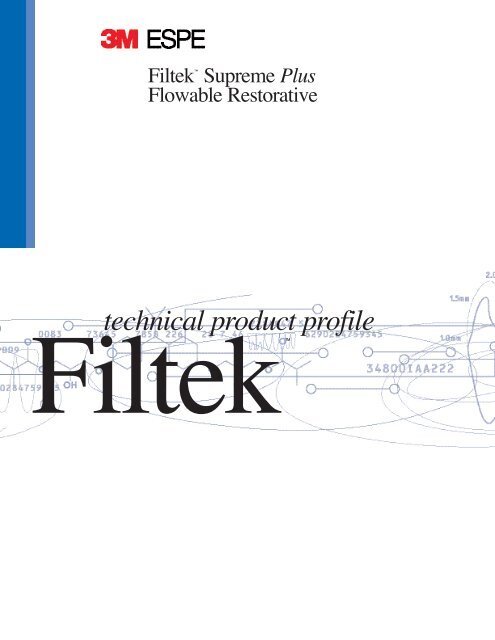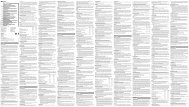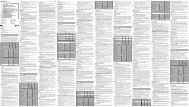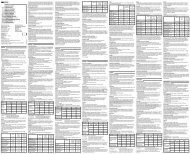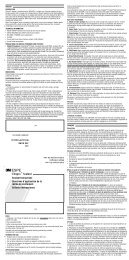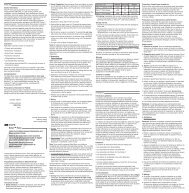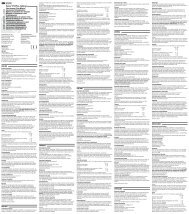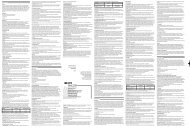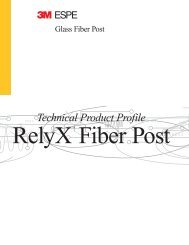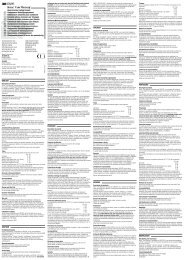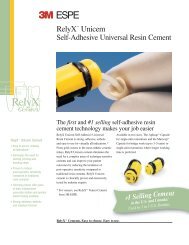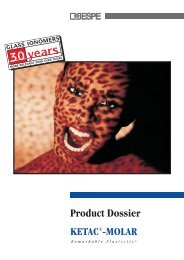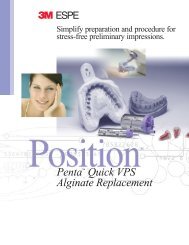Filtek Supreme Plus Flowable Restorative - 3M
Filtek Supreme Plus Flowable Restorative - 3M
Filtek Supreme Plus Flowable Restorative - 3M
Create successful ePaper yourself
Turn your PDF publications into a flip-book with our unique Google optimized e-Paper software.
<strong>Filtek</strong> <strong>Supreme</strong> <strong>Plus</strong><br />
<strong>Flowable</strong> <strong>Restorative</strong><br />
technical product profile<br />
<strong>Filtek</strong><br />
TM
Table of Contents<br />
Introduction . . . . . . . . . . . . . . . . . . . . . . . . . . . . . . . . . . . . . . . . . . . . . . . . . . . . . . . . . . . . . . . . . . . .5<br />
History . . . . . . . . . . . . . . . . . . . . . . . . . . . . . . . . . . . . . . . . . . . . . . . . . . . . . . . . . . . . . . . . . . . . . . . .5<br />
Product Description . . . . . . . . . . . . . . . . . . . . . . . . . . . . . . . . . . . . . . . . . . . . . . . . . . . . . . . . . . . . . .6<br />
Product Features . . . . . . . . . . . . . . . . . . . . . . . . . . . . . . . . . . . . . . . . . . . . . . . . . . . . . . . .6<br />
Indications for Use . . . . . . . . . . . . . . . . . . . . . . . . . . . . . . . . . . . . . . . . . . . . . . . . . . . . . . . . . . . . . .7<br />
Composition . . . . . . . . . . . . . . . . . . . . . . . . . . . . . . . . . . . . . . . . . . . . . . . . . . . . . . . . . . . . . . . . . . . .7<br />
Properties . . . . . . . . . . . . . . . . . . . . . . . . . . . . . . . . . . . . . . . . . . . . . . . . . . . . . . . . . . . . . . . . . . . . . .9<br />
Handling Properties . . . . . . . . . . . . . . . . . . . . . . . . . . . . . . . . . . . . . . . . . . . . . . . . . . . . . .9<br />
Tooth Brush Abrasion Test . . . . . . . . . . . . . . . . . . . . . . . . . . . . . . . . . . . . . . . . . . . . . . .11<br />
Wear . . . . . . . . . . . . . . . . . . . . . . . . . . . . . . . . . . . . . . . . . . . . . . . . . . . . . . . . . . . . . . . . .12<br />
Mechanical Properties . . . . . . . . . . . . . . . . . . . . . . . . . . . . . . . . . . . . . . . . . . . . . . . . . . .13<br />
Instructions for Use . . . . . . . . . . . . . . . . . . . . . . . . . . . . . . . . . . . . . . . . . . . . . . . . . . . . . . . . . . . . .16<br />
Precautions for Patients and Dental Personnel . . . . . . . . . . . . . . . . . . . . . . . . . . . . . . .16<br />
Warranty . . . . . . . . . . . . . . . . . . . . . . . . . . . . . . . . . . . . . . . . . . . . . . . . . . . . . . . . . . . . . . . . . . . . . .18<br />
References . . . . . . . . . . . . . . . . . . . . . . . . . . . . . . . . . . . . . . . . . . . . . . . . . . . . . . . . . . . . . . . . . . . .19<br />
3
Introduction<br />
<strong>3M</strong> ESPE <strong>Filtek</strong> <strong>Supreme</strong> <strong>Plus</strong> <strong>Flowable</strong> <strong>Restorative</strong> is a low viscosity, visible light-cured,<br />
radiopaque flowable restorative indicated for a variety of uses including liner/base, direct<br />
restorative for Class III ,V and minimally invasive preparations, pit and fissure sealant and<br />
repair of indirect composite, porcelain and temporary acrylic materials.<br />
<strong>Filtek</strong> <strong>Supreme</strong> <strong>Plus</strong> flowable restorative blends the strength and beauty of <strong>Filtek</strong> <strong>Supreme</strong> <strong>Plus</strong><br />
Universal <strong>Restorative</strong> with the “flow on demand” handling of <strong>3M</strong> ESPE <strong>Filtek</strong> Flow<br />
<strong>Flowable</strong> <strong>Restorative</strong>. Using the nanofiller technology of <strong>Filtek</strong> <strong>Supreme</strong> <strong>Plus</strong> universal restorative<br />
and the rheology modifier of <strong>Filtek</strong> Flow flowable restorative, <strong>3M</strong> ESPE has developed an esthetic<br />
flowable restorative with excellent wear and polish properties and handling optimized for a variety<br />
of indications.<br />
History<br />
<strong>Flowable</strong> composites became popular additions to the dentist’s armamentarium in the mid to late<br />
1990s. Composition often mimics that of a composite resin with one critical exception – that of a<br />
lower filler loading. Rada, in his 1998 article “The Versatility of <strong>Flowable</strong> Composites,” states:<br />
“<strong>Flowable</strong> composites offer an additional alternative in dentists’ tooth-colored restorative material<br />
selection. Their viscosity, consistency, handling characteristics, and delivery system make flowable<br />
resins a very attractive choice in selected cases.”<br />
<strong>Flowable</strong> composites, due to their limited filler loading, typically display lower physical properties<br />
than hybrid composites (Bayne 1998, Attar, 2003, Bonilla 2003). Thus, recommended indications<br />
have not included use in stress-bearing restorations. Rada considers flowables suitable as liners,<br />
Class V restorations, small Class I restorations including preventive resin restorations, small Class<br />
III resins, porcelain repairs, and the restoration of marginal defects. Behle (1998) emphasizes the<br />
excellent fit of the flowable concept into the trend towards conservative treatment techniques and<br />
microdentistry. A similar recommendation is offered by Peters and McLean (2001) who note that<br />
flowable composites “are excellently suited for minimally invasive cavities.” This includes various<br />
occlusal surface preparations (Preventive Resin Restorations involving only contiguous fissures;<br />
small “occlusal” preparations involving a significant portion of occlusal fissure pattern; sealants<br />
involving the use of dedicated burs) proximal slot and tunnel preparations and cervical preparations.<br />
<strong>Flowable</strong> composites also typically exhibit higher polymerization shrinkage than conventional<br />
composites. However, it is the polymerization stress that is ultimately destructive. Braga et al,<br />
(2003) reported that the polymerization stress of flowable composites was measured to be no<br />
greater than that measured for conventional composites. It was surmized that the lower elastic<br />
modulii (stiffness) of the flowable composites compared to conventional composites compensates<br />
for the higher shrinkage. This suggests that the risk of debonding during polymerization of a flowable<br />
composite should be no greater than the risk of debonding for a conventional composite.<br />
It has also been suggested that use of a low modulus flowable as a liner may absorb some of the<br />
polymerization stress of a conventional composite. Although Braga (2003), measured some stress<br />
relief when a flowable was modeled for use as a liner, its magnitude was found to be low and variable<br />
depending upon the flowable examined. The authors also note, however, that the lower modulii<br />
of the flowable composites may be beneficial in relieving stress at the bonded interface created<br />
by mechanical and thermal stimuli. Thus far, this benefit as measured by lower microleakage or<br />
reduced gap formation has been found in some laboratory studies (Ferdianakis (1998), Tung et al<br />
5
(2000), Leevailoj et al (2001), Fruits et al (2002), Yazici (2003)), but not in others (Jain et al<br />
(2001), Wibowo et al (2001)).<br />
Although the literature is equivocal on the benefit attributed to flowable materials in reducing<br />
microleakage or gaps at the bonded interface, the benefit associated with the reduction of voids or<br />
gaps during placement of traditional composite is intuitive. Due to their lower viscosity, it is<br />
expected that flowable materials will adapt to the cavosurface more readily than traditional composite<br />
especially the highly filled “packable” type. Marginal adaptation under packable resin composites<br />
has shown to be improved by the use of a flowable, as reported by Fabianelli et al (2003).<br />
Chuang et al (2001), while not finding reduced microleakage when using a flowable liner under<br />
Class II restoration, did report significant improvements in the reduction of voids in the restored<br />
interface.<br />
Finally, the potential clinical benefits of using flowable composites as a liner under a direct<br />
restorative has been noted. Unterbrink et al (1999) reviewed the literature pertaining to flowable<br />
composites as potential “filled adhesives,” concluding that flowable materials “appears to be one<br />
of the keys to achieving clinically acceptable results with single-component adhesives.”<br />
Christensen (2002) sites flowable resins as one of the techniques for reducing sensitivity when<br />
using the total etch bonding technique and surmizes that the flowable provides a buffer between<br />
tooth and restorative and potentially obturates any areas of inadequate seal between the bonding<br />
agent and the etched dentinal surface.<br />
Product Description<br />
<strong>Filtek</strong> <strong>Supreme</strong> <strong>Plus</strong> <strong>Flowable</strong> <strong>Restorative</strong> is a low viscosity, visible light-cured, radiopaque<br />
flowable restorative. Bonding to the tooth structure is accomplished through the use of a dental<br />
adhesive system, such as Adper Scotchbond Multi-Purpose Adhesive System, Adper Single<br />
Bond <strong>Plus</strong> Adhesive or Adper Prompt Self-Etch Adhesives. <strong>Filtek</strong> <strong>Supreme</strong> <strong>Plus</strong> flowable<br />
restorative can be used alone, after placing a compatible adhesive or in conjunction with a<br />
methacrylate-based restorative such as <strong>Filtek</strong> Z100 <strong>Restorative</strong>, <strong>Filtek</strong> Z250 <strong>Restorative</strong>,<br />
<strong>Filtek</strong> P60 <strong>Restorative</strong> or <strong>Filtek</strong> <strong>Supreme</strong> <strong>Plus</strong> Universal <strong>Restorative</strong>.<br />
Product Features<br />
• Packaged in 2, 2g syringes.<br />
• Directly dispensed through pre-bent disposable dispensing tips.<br />
• Available in 12 shades that correspond to the shades offered with <strong>Filtek</strong> <strong>Supreme</strong> <strong>Plus</strong><br />
Universal <strong>Restorative</strong>:<br />
– A1, A2, A3, A3.5, A4<br />
– B1, B2<br />
– C2<br />
– D2<br />
– OA3<br />
– W, XW<br />
6<br />
<strong>Filtek</strong> <strong>Supreme</strong> <strong>Plus</strong> flowable restorative is incrementally placed and cured using a 400-500nm<br />
visible curing light. The recommended maximum depth per increment and cure time is 2.0 mm for<br />
20 seconds for all shades except OA3 (2mm for 40 sec). These cure times can be reduced by onehalf<br />
when using the Elipar FreeLight 2 LED Curing Light.
Indications for Use<br />
• Class III and V restorations<br />
• Restoration of minimally invasive cavity preparations (including small, non stress-bearing<br />
occlusal restorations)<br />
• Base/liner under direct restorations<br />
• Repair of small defects in esthetic indirect restorations<br />
• Pit and fissure sealant<br />
• Undercut blockout<br />
• Repair of resin and acrylic temporary materials<br />
Composition<br />
Resin<br />
<strong>Filtek</strong> <strong>Supreme</strong> <strong>Plus</strong> <strong>Flowable</strong> <strong>Restorative</strong> is formulated with the methacrylate resin monomers<br />
Bis-GMA, TEGDMA and Bis-EMA. <strong>Filtek</strong> <strong>Supreme</strong> <strong>Plus</strong> flowable restorative also contains a<br />
dimethacrylate polymer that modifies the rheology of the material and provides a “flow on<br />
demand” handling characteristic allowing the material to flow under pressure, yet hold its shape<br />
after placement until light cured. A photoinitiator component allows for light-curing when exposed<br />
to visible light in the 400-500 nanometer range.<br />
Filler<br />
The filler in <strong>Filtek</strong> <strong>Supreme</strong> <strong>Plus</strong> flowable restorative is a combination of:<br />
• 75nm diameter non-agglomerated/non-aggregated silica nanofiller<br />
• 5-10nm diameter non-agglomerated/non-aggregated zirconia nanofiller<br />
• loosely bound agglomerated zirconia/silica nanocluster, consisting of agglomerates of 5-20nm<br />
primary zirconia/silica particles. The cluster particle size range is 0.6 to 1.4 microns.<br />
The inorganic filler loading is approximately 65% by weight (55% by volume).<br />
<strong>Filtek</strong> <strong>Supreme</strong> <strong>Plus</strong> flowable restorative incorporates fillers based on the patented nanofiller technology<br />
of <strong>Filtek</strong> <strong>Supreme</strong> <strong>Plus</strong> Universal <strong>Restorative</strong>. For <strong>Filtek</strong> <strong>Supreme</strong> <strong>Plus</strong> universal restorative,<br />
this technology is critical in achieving the high filler loading necessary to yield a restorative<br />
that is highly esthetic and has uncompromized strength. These properties were made possible by<br />
formulating the filler with a combination of individual nanoparticles together with clusters of<br />
loosly bound nanoparticles. This combination of nanofillers affords optimization of the filler packing<br />
architecture to maximize the restoratives mechanical, wear, polish and handling properties.<br />
<strong>Filtek</strong> <strong>Supreme</strong> <strong>Plus</strong> flowable restorative uses a similar strategy of combining individual nanoparticles<br />
with nanoclusters in an optimum configuration. The nanoclusters used in <strong>Filtek</strong> <strong>Supreme</strong><br />
<strong>Plus</strong> flowable restorative (page 8, SEM photomicrographs at 5,000X and 50,000X, courtesy of Dr.<br />
J Perdigao – University of Minnesota) are identical to those in the dentin, body and enamel shades<br />
of <strong>Filtek</strong> <strong>Supreme</strong> <strong>Plus</strong> universal restorative and consist of agglomerates of loosely bound 5-20nm<br />
zirconia/silica particles.<br />
7
<strong>Filtek</strong> <strong>Supreme</strong> <strong>Plus</strong><br />
<strong>Flowable</strong> <strong>Restorative</strong>,<br />
5K and 50K magnification.<br />
Photos courtesy of Dr. J.<br />
Perdigao, University of<br />
Minnesota<br />
Nanoclusters<br />
Nanoclusters<br />
To optimize the filler packing density, <strong>Filtek</strong> <br />
<strong>Supreme</strong> <strong>Plus</strong> flowable restorative contains two<br />
additional non-agglomerated/non-aggregated<br />
nanofillers (figure at right, TEM photomicrograph<br />
at 50,000X). One of these, a 75 nm nonagglomerated/non-aggregated<br />
silica nanofiller,<br />
is also present in the translucent shades of <strong>Filtek</strong><br />
<strong>Supreme</strong> <strong>Plus</strong> universal restorative. The other, a<br />
5-10 nm diameter zirconia particulate, is unique<br />
to <strong>Filtek</strong> <strong>Supreme</strong> <strong>Plus</strong> flowable restorative and<br />
75nm silica<br />
nanofiller<br />
Zirconia<br />
nanofiller<br />
is instrumental in conferring radiopacity comparable to the more highly filled <strong>Filtek</strong> <strong>Supreme</strong> <strong>Plus</strong><br />
universal restorative. Together, these two non-agglomerated/non-aggregated nanofillers contribute<br />
to more uniform filler density within the resin surrounding the micron and sub-micron nanoclusters<br />
than other flowable restoratives. This difference in filler density can be seen in the transmission<br />
electron microscopic (TEM) images shown below (in these figures, the scalloped nature of<br />
the larger filler particles is due to an artifact of the TEM sample preparation). This optimized<br />
“interstitial” filler architecture contributes to the excellent physical, wear and polish properties of<br />
<strong>Filtek</strong> <strong>Supreme</strong> <strong>Plus</strong> flowable restorative while still allowing for the desirable handling of a flowable<br />
restorative.<br />
TEM photomicrographs at<br />
32,000X magnification<br />
(top row l to r)<br />
<strong>Filtek</strong> <strong>Supreme</strong> <strong>Plus</strong><br />
<strong>Flowable</strong>, EsthetX® Flow<br />
(bottom row l to r)<br />
Revolution Formula 2,<br />
Tetric® Flow<br />
8
Properties<br />
<strong>Filtek</strong> <strong>Supreme</strong> <strong>Plus</strong> <strong>Flowable</strong> <strong>Restorative</strong> was tested and found to be in compliance with ISO<br />
4049:2000(E), “Dentistry–Polymer-based filling, restorative and luting materials” and ISO/FDIS<br />
6874:2005(E), “Dentistry – Polymer-based Pit and Fissure Sealants.” Additional tests presented<br />
below include polish retention, wear resistance, compressive and diametral tensile strengths and<br />
flexural modulus. All tests were performed at <strong>3M</strong> ESPE Laboratories unless otherwise noted.<br />
Handling Properties<br />
Considering the indications where flowable restoratives are typically used, the ideal flowable<br />
would flow readily when manipulated, yet hold its shape once placed. Such properties were realized<br />
for flowable restoratives with the introduction of <strong>Filtek</strong> Flow <strong>Flowable</strong> <strong>Restorative</strong> in 2000.<br />
Building on the chemistry of <strong>Filtek</strong> Flow flowable restorative, <strong>Filtek</strong> <strong>Supreme</strong> <strong>Plus</strong> <strong>Flowable</strong><br />
<strong>Restorative</strong> incorporates the same rheological modifier as its predecessor. This additive enables the<br />
viscosity of <strong>Filtek</strong> <strong>Supreme</strong> <strong>Plus</strong> flowable restorative to change when manipulated offering greater<br />
control during placement.<br />
As the photograph at right shows, many flowable<br />
composites will run when subjected to gravitational<br />
force. This property makes control of<br />
the restorative difficult in certain indications<br />
such as Class V restorations. As seen in the photograph,<br />
<strong>Filtek</strong> <strong>Supreme</strong> <strong>Plus</strong> flowable restorative<br />
holds its shape under these conditions.<br />
However, when a shear force is applied to <strong>Filtek</strong> <strong>Supreme</strong> <strong>Plus</strong> flowable restorative, such as during<br />
extrusion through the dispensing tip and manipulation onto the preparation, the viscosity of the<br />
restorative decreases. This means <strong>Filtek</strong> <strong>Supreme</strong> <strong>Plus</strong> flowable restorative becomes more fluid<br />
allowing for easy adaptation to the preparation. Once this shear force is removed, such as when<br />
manipulation stops, <strong>Filtek</strong> <strong>Supreme</strong> <strong>Plus</strong> flowable restorative returns to its original, non slumping,<br />
viscosity.<br />
This property is demonstrated in the photo series below where <strong>Filtek</strong> <strong>Supreme</strong> <strong>Plus</strong> flowable<br />
restorative was placed on a vertically positioned glass slide and the slide subjected to a shearing<br />
force, in this case, by contacting the slide to a laboratory vibrator. In its resting viscosity (A), no<br />
flow occurs and <strong>Filtek</strong> <strong>Supreme</strong> <strong>Plus</strong> flowable restorative retains its shape. When a shear force is<br />
applied (B), the viscocity decreases and flow occurs under the force of gravity. Upon stopping the<br />
force (C), <strong>Filtek</strong> <strong>Supreme</strong> <strong>Plus</strong> flowable returns to its resting viscosity and flow ceases. Additional<br />
flow occurs during a second shear cycle (D) and ceases, once again (E), as the force is stopped.<br />
A B C D E<br />
Shear<br />
Force<br />
Shear<br />
Force<br />
Time<br />
(sec)<br />
Viscosity<br />
9
Polish Retention<br />
Filler composition has a significant impact on<br />
the ability of a resin composite to retain its polish<br />
in the oral environment. As resin is lost<br />
from the surface of a traditional hybrid and<br />
micro-hybrid composite due to abrasive forces,<br />
filler particles are exposed and the surface<br />
becomes highly irregular. Over time, these particles,<br />
some measuring over one micron in<br />
diameter, may be lost creating pits or voids at the surface which leads to further irregularity. This<br />
roughness causes significant scattering of light (and a reduction in reflectivity) that is observed<br />
visually as a loss of polish or gloss.<br />
The filler composition of many flowable restoratives is similar to that used in traditional composite<br />
restoratives with mean particle sizes often approaching one micron (Figures below, Dr. J<br />
Perdigao – University of Minnesota). It is expected that the surface irregularity and loss of polish<br />
with these flowable restoratives will, conservatively, mimic that of the traditional hybrid and<br />
micro-hybrid composites when subjected to an abrasive mechanism. Due to their relatively higher<br />
resin content, it is more likely, however, that the surface irregularity of these hybrid and microhybrid<br />
flowable materials will be greater than the more highly filled traditional composites.<br />
SEM photomicrographs at<br />
30,000X magnificaton<br />
(top row, l to r) Flow-It®<br />
ALC, EsthetX® Flow<br />
(bottom row, l to r)<br />
Tetric® Flow, Revolution®<br />
Formula 2<br />
Photos courtesy of Dr. J.<br />
Perdigao, University of<br />
Minnesota<br />
10<br />
<strong>Filtek</strong> <strong>Supreme</strong> <strong>Plus</strong><br />
<strong>Flowable</strong> <strong>Restorative</strong><br />
30,000X magnification<br />
As previously discussed, the filler composition<br />
in <strong>Supreme</strong> branded restoratives contain primary<br />
particles less than 100nm in diameter<br />
(Figure at right, Dr. J Perdigao). While the nanocluster<br />
particle size can exceed one micron in<br />
Nanocluster<br />
diameter, during abrasive wear, it is the primary<br />
particles that are predominantly lost. With<br />
<strong>Filtek</strong> <strong>Supreme</strong> <strong>Plus</strong> Universal <strong>Restorative</strong>,<br />
the resultant surface irregularity and associated<br />
loss of polish has shown to be reduced compared to traditional hybrid and micro-hybrid composites.<br />
As shown below, incorporating this nanofiller technology into <strong>Filtek</strong> <strong>Supreme</strong> <strong>Plus</strong> <strong>Flowable</strong><br />
<strong>Restorative</strong> has resulted in a similar benefit.
Tooth Brush Abrasion Test<br />
Cured, rectangular samples of various flowable materials were polished using a Buehler<br />
ECOMET 4 Polisher with an AUTOMET 2 Polishing Head. The following sequence of abrasive<br />
was used for each sample – 320 grit, 600 grit silicon carbide abrasive, 9 mm diamond polishing<br />
paste, 3mm diamond polishing paste and finally a Master Polishing Solution.<br />
A micro-tri-gloss instrument (BYK Gardner, Columbia, MD) was used to collect photoelectric<br />
measurements of specularly reflected light from the sample surface after polishing and after tooth<br />
brushing. The procedure described in ASTM D 523-89 (Reapproved 1994) Standard Test Method<br />
for Specular Gloss, for measurements made at 60A1 geometry was followed. Initial gloss after<br />
polishing was measured for initial sample. Gloss readings were recorded after 500 tooth-brushing<br />
cycles. Each sample was brushed with an ORAL B 40 medium Straight toothbrush (Oral B<br />
Laboratories, Belmont, CA.) using CREST Regular Flavor (Proctor & Gamble, Cincinnati, OH)<br />
toothpaste. The toothbrush and sample were mounted on a device that controlled the stroke length<br />
and force on the toothbrush head.<br />
The gloss measured after each 500 stroke cycle is shown above. After 2000 cycles, the measured<br />
gloss was statistically higher for <strong>Filtek</strong> <strong>Supreme</strong> <strong>Plus</strong> flowable restorative in comparison to the<br />
other flowable restoratives shown. Examining the samples using scanning electron microscopy<br />
provides a visual comparison of surface irregularity among the materials.<br />
Figure 1.<br />
Tooth Brush Abrasion<br />
Scanning electron photomicrographs<br />
of representative<br />
samples from tooth<br />
brush abrasion test.<br />
5000X Magnification.<br />
(l to r) <strong>Filtek</strong> <strong>Supreme</strong><br />
<strong>Plus</strong> <strong>Flowable</strong> <strong>Restorative</strong>,<br />
EsthetX® Flow<br />
11
Scanning electron photomicrographs<br />
of representative<br />
samples from tooth<br />
brush abrasion test. 5000X<br />
Magnification.<br />
(top row, l to r) Revolution®<br />
Formula 2, Tetric® Flow<br />
(bottom row, l to r)<br />
Flow-It® ALC , <strong>Filtek</strong> Flow<br />
Wear<br />
A 3-body wear model is a clinically relevant test for predicting the relative wear between<br />
materials intended for non-stress bearing restorations. In this test (ACTA), the sample (1st body)<br />
is loaded onto a wheel (see shaded slots in diagram at left) which contacts another wheel acting as<br />
an “antagonistic cusp” (2nd body). The two wheels counter-rotate against one another dragging an<br />
abrasive slurry (3rd body) between them. Following each cycle set, vertical loss of the test materials<br />
was measured using a contact stylus. Wear measurements were made at 39,000 cycle increments<br />
for a total of 234,000 cycles. The wear rate for <strong>Filtek</strong> <strong>Supreme</strong> <strong>Plus</strong> <strong>Flowable</strong> <strong>Restorative</strong><br />
was compared to competitive flowable materials, two traditional hybrid composites and the<br />
nanocomposite, <strong>Filtek</strong> <strong>Supreme</strong> <strong>Plus</strong> Universal <strong>Restorative</strong>. The results are illustrated in Figure 2.<br />
It was determined that the wear for <strong>Filtek</strong> <strong>Supreme</strong> <strong>Plus</strong> flowable restorative was statistically less<br />
(indicating better wear resistance) than all of the other flowable composites and equivalent to the<br />
traditional composite materials TPH 3 and Tetric® Evo Ceram.<br />
The lower filler to resin ratio of flowable composites is the primary contributor to decreased wear<br />
resistance in comparison to traditional resin composites. For materials with similar filler loading,<br />
other factors, such as filler composition, are expected to contribute to the wear properties. For<br />
<strong>Filtek</strong> <strong>Supreme</strong> <strong>Plus</strong> flowable restorative, the contribution of the various nanofillers are thought<br />
to be instrumental in reducing the wear rate to levels equivalent to the two traditional composites<br />
noted above despite having significantly less filler than these materials.<br />
12
Figure 2.<br />
Wear rate<br />
Mechanical Properties<br />
Compressive and Diametral Tensile Strengths<br />
The ultimate compressive strength involves measuring the compressive force at which the sample<br />
fails destructively. Cylindrical samples were made of the test materials and a compressive force<br />
applied as indicated in the figure at right. Sample failure is a result of a complex pattern of shear<br />
and tensile forces within the sample. The compressive strength of various materials are reported in<br />
the chart below.<br />
<strong>Filtek</strong> <strong>Supreme</strong> <strong>Plus</strong> <strong>Flowable</strong> <strong>Restorative</strong> has statistically higher compressive strength in comparison<br />
to Dyract Flow® and Esthet X® Flow.<br />
Figure 3.<br />
Compressive Stength<br />
Tensile strength of flowable restoratives were examined using the diametral tensile test. In this test,<br />
a compressive force is applied to the sample shaped in the form of a disc. This introduces a tensile<br />
stress in the plane parallel to the applied stress as shown in diagram at right. The diametrile tensile<br />
strength is determined from the force at which sample failure occurs and the sample geometry.<br />
The diametral tensile strengths of various materials are reported in Figure 4.<br />
13
Figure 4.<br />
Diametral Tensile Strength<br />
The diametral strength of <strong>Filtek</strong> <strong>Supreme</strong> <strong>Plus</strong> <strong>Flowable</strong> <strong>Restorative</strong> is statistically greater than<br />
that measured for Dyract Flow®, Heliomolar® Flow and Revolution® Formula 2.<br />
Flexural Strength and Flexural Modulus<br />
Flexural strength was determined per ISO 4049:2000(E) Dentistry – Polymer-based filling,<br />
restorative and luting materials. A rectangular beam, supported at each end is subjected to a<br />
perpendicular force as shown in the diagram at left. The flexural strength is related to the force<br />
at which the beam fails and the sample geometry. The flexural modulus is an indication of the<br />
stiffness of the beam and is determined by measuring the deformation of the beam as the force<br />
is initially applied. The flexural strength and modulii for various flowable materials are shown<br />
in Figure 5.<br />
Figure 5.<br />
Flexural Strength<br />
Figure 6.<br />
Flexural Modulus<br />
The flexural strength of <strong>Filtek</strong> <strong>Supreme</strong> <strong>Plus</strong> flowable restorative approaches that measured for<br />
<strong>Filtek</strong> <strong>Supreme</strong> <strong>Plus</strong> Universal <strong>Restorative</strong>. The modulii for the flowable materials are similar<br />
and lower than that measured for <strong>Filtek</strong> <strong>Supreme</strong> <strong>Plus</strong> universal restorative.<br />
14
Radiopacity<br />
The zirconia nanofiller and zirconia/silica nanocluster imparts radiopacity to <strong>Filtek</strong> <strong>Supreme</strong> <strong>Plus</strong><br />
<strong>Flowable</strong> <strong>Restorative</strong>. The radiopacity was determined per ISO 4049-2000(E). In this method, the<br />
optical density of a radiograph of the cured material is compared to that of an aluminum block of<br />
the same thickness. The radiopacity is reported as the ratio of the optical density of the aluminum<br />
sample to that of the test sample. Ratio values greater than 1.0 are considered to be radiopaque.<br />
Ratio values less than 1.0 are not considered radiopaque by this test standard. The radiopacity<br />
value for the <strong>Filtek</strong> <strong>Supreme</strong> <strong>Plus</strong> flowable restorative is 1.89 and is therefore radiopaque.<br />
Comparison among materials reveals that <strong>Filtek</strong> <strong>Supreme</strong> <strong>Plus</strong> flowable restorative is equivalent to<br />
that for <strong>Filtek</strong> <strong>Supreme</strong> Universal <strong>Restorative</strong> and significantly greater than that for EsthetX®<br />
Flow, Revolution® Formula 2, Point 4 <strong>Flowable</strong> and <strong>Filtek</strong> Flow <strong>Flowable</strong> <strong>Restorative</strong>.<br />
Figure 7.<br />
Radiopacity<br />
Polymerization Shrinkage<br />
The method for determining the volumetric shrinkage was described by Watts and Cash (Meas.<br />
Sci. Technol. 2(1991) 788-794). In this method, a disc shaped test specimen is sandwiched<br />
between two glass plates and light cured through the lower rigid plate (see diagram at right). The<br />
flexible upper plate is deflected during polymerization of the test specimen. The less the flexible<br />
plate bends, the lower the shrinkage. The vertical deflection measured, under the constraints of the<br />
sample geometry, is related to the volumetric shrinkage. The chart below shows that the polymerization<br />
shrinkage for <strong>Filtek</strong> <strong>Supreme</strong> <strong>Plus</strong> flowable restorative is statistically lower than that for<br />
EsthetX Flow, Dyract Flow and Revolution Formula 2.<br />
Figure 8.<br />
Volumetric Shrinkage<br />
Independent verification of the extent of polymerization shrinkage was provided by Louisiana<br />
State University (LSU) in New Orleans. Shrinkage value reported was obtained ten minutes post<br />
light curing using the Acuvol method. The results are in good agreement with the those reported<br />
above.<br />
Figure 9.<br />
Volumetric Shrinkage<br />
15
Instructions for Use<br />
<strong>Filtek</strong> <strong>Supreme</strong> <strong>Plus</strong> <strong>Flowable</strong> <strong>Restorative</strong><br />
General<br />
<strong>Filtek</strong> <strong>Supreme</strong> <strong>Plus</strong> <strong>Flowable</strong> <strong>Restorative</strong>, manufactured by <strong>3M</strong> ESPE, is a low viscosity, visiblelight<br />
activated, radiopaque, flowable nanocomposite based on <strong>3M</strong> ESPE <strong>Filtek</strong> <strong>Supreme</strong> <strong>Plus</strong><br />
Universal <strong>Restorative</strong>. The restorative is packaged in syringes and available in a variety of toothcolored<br />
shades. The shades offered with <strong>Filtek</strong> <strong>Supreme</strong> <strong>Plus</strong> flowable restorative were designed<br />
to coordinate with shades offered with <strong>Filtek</strong> <strong>Supreme</strong> <strong>Plus</strong> Universal <strong>Restorative</strong>. <strong>Filtek</strong> <strong>Supreme</strong><br />
<strong>Plus</strong> flowable restorative contains bisGMA, TEGDMA and bis-EMA resins. The filler in <strong>Filtek</strong><br />
<strong>Supreme</strong> <strong>Plus</strong> flowable restorative is a combination of non-agglomerated/non-aggregated, 75nm<br />
silica nanofiller; non-agglomerated/non-aggregated, 15-20nm zirconia nanofiller and loosely<br />
bound agglomerated zirconia/silica nanocluster, consisting of agglomerates of 5-20nm primary zirconia/silica<br />
particles. The cluster particle size range is 0.6 to 1.4 microns. The inorganic filler loading<br />
is approximately 65% by weight (55% by volume).<br />
Indications<br />
• Restoration of minimally invasive cavity preparations (including Class III and V restorations<br />
and occlusal pits and fissures)<br />
• Base/liner under direct restorations<br />
• Repair of small defects in esthetic indirect restorations<br />
• Pit and fissure sealant<br />
• Undercut blockout<br />
• Repair of resin and acrylic temporary materials<br />
Precautions for Patients and Dental Personnel<br />
Precautionary Information for Patients:<br />
Avoid use of this product in patients with known acrylate allergies. This product contains substances<br />
that may cause an allergic reaction by skin contact in certain individuals. If prolonged contact<br />
with oral soft tissue occurs, flush with large amounts of water. If allergic reaction occurs, seek<br />
medical attention as needed, remove the product if necessary and discontinue future use of the<br />
product.<br />
Precautionary Information for Dental Personnel:<br />
This product contains substances that may cause an allergic reaction by skin contact in certain<br />
individuals. To reduce the risk of allergic response, minimize exposure to these materials. In particular,<br />
avoid exposure to uncured product. If skin contact occurs, wash skin with soap and water.<br />
Use of protective gloves and a no-touch technique is recommended. Acrylates may penetrate commonly<br />
used gloves. If product contacts glove, remove and discard glove, wash hands immediately<br />
with soap and water and then re-glove. If allergic reaction occurs, seek medical attention as needed.<br />
Protective eyewear for patients and staff is recommended when using dispensing tip.<br />
16
Instructions for Use<br />
I) Preliminary<br />
A. Prophy: Teeth should be cleaned with pumice and water to remove surface stains.<br />
B. Shade Selection: Prior to isolation of tooth, select the appropriate shade(s) of <strong>Filtek</strong> <strong>Supreme</strong><br />
<strong>Plus</strong> flowable restorative using a standard VitaPan® Classic shade guide. Shade selection<br />
accuracy may be enhanced via a mock-up: place the chosen shade of the restorative material<br />
on the unetched tooth. Manipulate the material to approximate the thickness and site of the<br />
restoration. Cure. Evaluate the shade match under different lighting sources. Remove the<br />
restorative material from the unetched tooth with an explorer. Repeat process until an acceptable<br />
shade match is achieved.<br />
For sealants, a contrasting shade may be desirable to enhance detection.<br />
C. Isolation: A rubber dam is the preferred method of isolation. Cotton rolls and an evacuator<br />
can also be used.<br />
II) Directions<br />
A. Isolate and dry the preparation.<br />
B. Pulp protection: If a pulp exposure has occurred and the situation warrants a direct pulp capping<br />
procedure, use a minimum amount of calcium hydroxide on the exposure followed by<br />
an application of Vitrebond Light Cure Glass Ionomer, manufactured by <strong>3M</strong> ESPE.<br />
Vitrebond may also be used to line areas of deep cavity excavation.<br />
C. Adhesive System: Follow manufacturer’s instructions regarding placement.<br />
Note: Silane treatment is recommended for repair of ceramic restorations followed by the<br />
adhesive application.<br />
D. Dispensing: <strong>Filtek</strong> <strong>Supreme</strong> <strong>Plus</strong> flowable restorative can be delivered directly from the dispensing<br />
tip.<br />
1. Protective eyewear for patients and staff is recommended when using the dispensing tip.<br />
2. Prepare the dispensing tip: Remove cap and SAVE. Twist the prebent disposable dispensing<br />
tip securely onto the syringe. Holding the tip away from the patient and any dental<br />
staff, express a small amount of <strong>Filtek</strong> <strong>Supreme</strong> <strong>Plus</strong> flowable restorative to assure<br />
that the delivery system is not plugged.<br />
3. If plugged, remove the dispensing tip and express a small amount of <strong>Filtek</strong> <strong>Supreme</strong> <strong>Plus</strong><br />
flowable restorative directly from the syringe. Remove any visible plug, if present, from<br />
the syringe opening. Replace dispensing tip and again express composite. <strong>Filtek</strong><br />
<strong>Supreme</strong> <strong>Plus</strong> flowable restorative may be extruded onto a dispensing pad and applied<br />
with a brush or other appropriate instrument.<br />
E. Placement:<br />
1. Place and light cure restorative in increments as indicated in Section F.<br />
2. Avoid intense light in the working field.<br />
3. To prevent oozing of paste from the syringe tip after placement, pull back on syringe<br />
plunger.<br />
F. Curing: <strong>Filtek</strong> <strong>Supreme</strong> <strong>Plus</strong> <strong>Flowable</strong> <strong>Restorative</strong> will cure only by exposure to light. Cure<br />
each increment by exposing its entire surface to a high intensity visible light source, such as a<br />
17
<strong>3M</strong> ESPE curing light. Hold the light guide tip as close to the restorative as possible during<br />
light exposure.<br />
G. Complete the restoration:<br />
Shade Increment depth Cure time<br />
Opaque A3 2.0mm 40 sec<br />
All other shades - 2.0mm 20 sec<br />
1. Base/Liner application: place a composite restorative material, such as <strong>Filtek</strong> <strong>Supreme</strong><br />
<strong>Plus</strong> Universal <strong>Restorative</strong>, manufactured by <strong>3M</strong> ESPE, directly over the cured <strong>Filtek</strong><br />
<strong>Supreme</strong> <strong>Plus</strong> flowable restorative. Follow the manufacturer’s instructions regarding<br />
placement, curing, finishing, occlusal adjustment, and polishing.<br />
2. Direct <strong>Restorative</strong> Application:<br />
a) Contour restoration surfaces with fine finishing diamonds, burs or stones.<br />
b) Check occlusion with a thin articulating paper. Examine centric and lateral excursion<br />
contacts. Carefully adjust occlusion by removing material with a fine polishing diamond<br />
or stone.<br />
c) Polish with Sof-Lex Finishing and Polishing System, manufactured by <strong>3M</strong> ESPE, or<br />
with white stones, rubber points or polishing paste where discs are not suitable.<br />
3. Pit and Fissure Sealants: gently remove the inhibited layer remaining after light-curing<br />
with a slurry of pumice or polishing paste.<br />
III) Storage and Use:<br />
A. <strong>Filtek</strong> <strong>Supreme</strong> <strong>Plus</strong> flowable restorative is designed for use at room temperature of approximately<br />
21-24°C or 70-75°F. Shelf life at room temperature is 2 years. See outer package for<br />
expiry date.<br />
B. Do not expose restorative materials to elevated temperatures or intense light.<br />
C. Storage in refrigerator ensures longest possible shelf life. Allow to reach room temperature<br />
prior to use.<br />
D. Do not store materials in proximity to eugenol containing products.<br />
E. Disinfection: Discard used syringe tip and replace with syringe storage cap. Disinfect the<br />
capped syringe using an intermediate level disinfection process (liquid contact) as recommended<br />
by the CDC and endorsed by the ADA. Guidelines for Infection Control in Dental<br />
Health-Care Settings – 2003 (Vol.52; No. RR-17), Centers for Disease Control and<br />
Prevention.<br />
No person is authorized to provide any information which deviates from the information provided<br />
in this instruction sheet.<br />
Warranty<br />
<strong>3M</strong> ESPE warrants this product will be free from defects in material and manufacture. <strong>3M</strong> ESPE<br />
MAKES NO OTHER WARRANTIES INCLUDING ANY IMPLIED WARRANTY OF MER-<br />
CHANTABILITY OR FITNESS FOR A PARTICULAR PURPOSE. User is responsible for<br />
determining the suitability of the product for user’s application. If this product is defective within<br />
the warranty period, your exclusive remedy and <strong>3M</strong> ESPE’s sole obligation shall be repair or<br />
replacement of the <strong>3M</strong> ESPE product.<br />
18
Limitation of Liability<br />
Except where prohibited by law, <strong>3M</strong> ESPE will not be liable for any loss or damage arising from<br />
this product, whether direct, indirect, special, incidental or consequential, regardless of the theory<br />
asserted, including warranty, contract, negligence or strict liability.<br />
References<br />
Attar N, Tam LE, McComb D. Flow, strength, stiffness and radiopacity of flowable resin composites.<br />
J Can Dent Assoc. 2003;69(8):516-21.<br />
Bayne SC, Thompson JY, Swift EJ Jr, Stamatiades P, Wilkerson M. A characterization of first generation<br />
flowable composites. J Am Dent Assoc. 1998;129(5):567-77.<br />
Behle C. Pract Periodontics. <strong>Flowable</strong> composites: properties and applications. Aesthet Dent.<br />
1998;10(3):347, 350-1. Bonilla ED, Yashar M, Caputo AA. Fracture toughness of nine flowable<br />
resin composites. J Prosthet Dent. 2003 Mar;89(3):261-7.<br />
Braga RR, Hilton TJ, Ferracane JL. Contraction stress of flowable composite materials and their<br />
efficacy as stress-relieving layers. J Am Dent Assoc. 2003, 134, 721-728.<br />
Chuang SF, Liu JK, Chao CC, Liao FP, Chen YH. Effects of flowable composite lining and<br />
operator experience on microleakage and internal voids in class II composite restorations. J<br />
Prosthet Dent. 2001 Feb;85(2):177-83.<br />
Christensen GJ. Preventing postoperative tooth sensitivity in Class I, II and V restorations. J Am<br />
Dent Assoc. 2002 Feb;133(2):229-31.<br />
Fabianelli A, Goracci C, Ferrari M.J Sealing ability of packable resin composites in class II<br />
restorations. Adhes Dent. 2003;5(3):217-23.<br />
Ferdianakas K. Microleakage reduction from newer esthetic restorative materials in permanent<br />
molars. J Clin Pediatr Dent 1998, 23:221-9.<br />
Fruits TJ, VanBrunt CL, Khajotia SS, Duncanson Jr. MG. Effect of cyclical lateral forces on<br />
microleakage in cervical resin composite restorations. Quintessence Int 2002;33:205-12.<br />
Jain P, Belcher M. Microleakage of class II resin-based composite restorations with flowable<br />
composite in the proximal box. Am J Dent. 2000;13:235-8.<br />
Peters MC, McLean ME. Minimally invasive operative care, II. Contemporary techniques and<br />
materials: An overview. J Adhes Dent. 2001 3(1), 17-31.<br />
Rada RE. The versatility of flowable composites. Dent Today. 1998;17(4):78-83.<br />
Tung FF, Hsieh WW, Estafan D. In vitro microleakage study of a condensable and flowable<br />
composite resin. Gen Dent. 2000;48(6):711-5.<br />
Unterbrink GL, Liebenberg WH. <strong>Flowable</strong> resin composites as “filled adhesives”: literature<br />
review and clinical recommendations.Quintessence Int. 1999;30(4):249-57.<br />
Wibowo G, Stockton L, Microleakage of class II composite restorations. Am J Dent 2001;14:177-85.<br />
Yazici AR, Baseren M, Dayangac B. The effect of flowable resin composite on microleakage in<br />
class V cavities. Oper Dent. 2003 Jan-Feb;28(1):42-6.<br />
19
Dental Products<br />
<strong>3M</strong> Center<br />
Building 275-2SE-03<br />
St. Paul, MN 55144-1000<br />
USA<br />
<strong>3M</strong> Canada<br />
Post Office Box 5757<br />
London, Ontario N6A 4T1<br />
Canada<br />
1-800-265-1840 ext. 6229<br />
10% post-consumer<br />
waste paper<br />
Printed in USA<br />
© <strong>3M</strong> 2005 All rights reserved.<br />
<strong>3M</strong>, ESPE, Adper, Elipar, <strong>Filtek</strong>, Prompt,<br />
Scotchbond, Sof-Lex and Vitrebond are<br />
trademarks of <strong>3M</strong> ESPE or <strong>3M</strong> ESPE AG.<br />
Used under license in Canada. Dyract,<br />
EsthetX and TPH are registered trademark of<br />
Dentsply/Caulk. Tetric and Heliomolar are<br />
registered trademarks of Ivoclar/Vivadent.<br />
Revolution is a registered trademark and<br />
Point 4 is a trademark of Kerr. Virtuoso is a<br />
trademark of Den-Mat. Flow-It is a registered<br />
trademark and ALC is a trademark of<br />
Pentron Corporation. Oral-B is a trademark<br />
of Oral-B Laboratories. Crest is a trademark<br />
of Proctor and Gamble. VITAPAN is a registered<br />
trademark of Zahnfabrik H Rauter<br />
GmbH & Co KG.<br />
70-2009-3747-5


